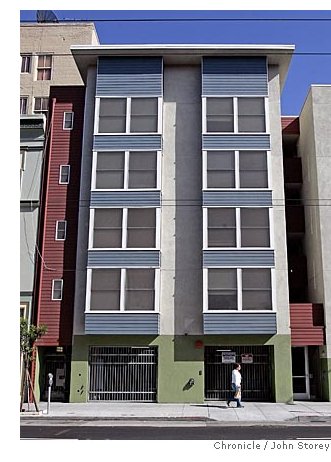| |
Keys to Affordable Housing
August 31, 2005
 This is the new face of affordable housing--the tallest Habitat for Humanity project in the world
(five stories) which was built by the San Francisco affiliate on Mission Street. I contributed to a feature
on affordable housing in Saturday's San Francisco Chronicle highlighting a number of affordable housing
projects which are virtually identical to market-rate housing.
This is the new face of affordable housing--the tallest Habitat for Humanity project in the world
(five stories) which was built by the San Francisco affiliate on Mission Street. I contributed to a feature
on affordable housing in Saturday's San Francisco Chronicle highlighting a number of affordable housing
projects which are virtually identical to market-rate housing.
I've covered affordable housing in the past (a two-part S.F. Chronicle feature in 2001), and my recent research and interviews
reinforced these salient points:
Market forces alone have not and cannot construct affordable housing in expensive markets such as the
San Francisco Bay Area. With land costing $200,000 per unit, there is no way a builder can acquire land
and build a dwelling for an affordable price.
Government intervention is a necessary ingredient in the creation of affordable housing. Requiring 10-20% of
new homes to be affordable forces developers to either subsidize the lower-cost units by raising the price of
the market-rate homes or get creative. For instance, some builders have deeded open lots to Habitat for
Humanity as a way of meeting their affordable housing requirements.
The most straightforward way to lower the cost of affordable housing is for the government to give surplus
land to non-profit developers. This reduces the cost by 40% (at least locally) right off the top.
Government-backed low-interest loans and tax credits also reduce the final cost of affordable housing by
lowering the cost of borrowing. In the long run, the cost of money (paying interest on the mortgage) can
exceed the actual cost of land and construction, so lowering the cost of money keeps rental housing affordable
over the long-term.
There is no way to lower the construction costs other than donated labor and materials, which is the Habitat
for Humanity model.
Building attractive housing with a mix of residents (renters and owners, low and moderate incomes) is
the only model which serves the interests of the community and residents in the long-term, and this is the model
being pursued by non-profit developers large and small. The notion of "warehousing the poor" in instant tenaments has
been rejected as a failed experiment.
It is possible to build enduringly liveable affordable housing, but it requires government and community
support and the expertise of experienced architects, planners and developers. Communities without these
assets simply don't get any affordable housing built, and are much the poorer for it.
* * *
copyright © 2005 Charles Hugh Smith. All rights reserved in all media.
I would be honored if you linked this wEssay to your site, or printed a copy for your own use.
* * *
|
|


 This is the new face of affordable housing--the tallest Habitat for Humanity project in the world
(five stories) which was built by the San Francisco affiliate on Mission Street. I contributed to a feature
on affordable housing in Saturday's San Francisco Chronicle highlighting a number of affordable housing
projects which are virtually identical to market-rate housing.
This is the new face of affordable housing--the tallest Habitat for Humanity project in the world
(five stories) which was built by the San Francisco affiliate on Mission Street. I contributed to a feature
on affordable housing in Saturday's San Francisco Chronicle highlighting a number of affordable housing
projects which are virtually identical to market-rate housing.